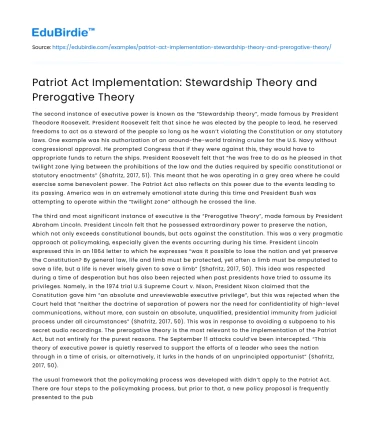The second instance of executive power is known as the “Stewardship theory”, made famous by President Theodore Roosevelt. President Roosevelt felt that since he was elected by the people to lead, he reserved freedoms to act as a steward of the people so long as he wasn’t violating the Constitution or any statutory laws. One example was his authorization of an around-the-world training cruise for the U.S. Navy without congressional approval. He prompted Congress that if they were against this, they would have to appropriate funds to return the ships. President Roosevelt felt that “he was free to do as he pleased in that twilight zone lying between the prohibitions of the law and the duties required by specific constitutional or statutory enactments” (Shafritz, 2017, 51). This meant that he was operating in a grey area where he could exercise some benevolent power. The Patriot Act also reflects on this power due to the events leading to its passing. America was in an extremely emotional state during this time and President Bush was attempting to operate within the “twilight zone” although he crossed the line.
The third and most significant instance of executive is the “Prerogative Theory”, made famous by President Abraham Lincoln. President Lincoln felt that he possessed extraordinary power to preserve the nation, which not only exceeds constitutional bounds, but acts against the constitution. This was a very pragmatic approach at policymaking, especially given the events occurring during his time. President Lincoln expressed this in an 1864 letter to which he expresses “was it possible to lose the nation and yet preserve the Constitution? By general law, life and limb must be protected, yet often a limb must be amputated to save a life, but a life is never wisely given to save a limb” (Shafritz, 2017, 50). This idea was respected during a time of desperation but has also been rejected when past presidents have tried to assume its privileges. Namely, in the 1974 trial U.S Supreme Court v. Nixon, President Nixon claimed that the Constitution gave him “an absolute and unreviewable executive privilege”, but this was rejected when the Court held that “neither the doctrine of separation of powers nor the need for confidentiality of high-level communications, without more, can sustain an absolute, unqualified, presidential immunity from judicial process under all circumstances” (Shafritz, 2017, 50). This was in response to avoiding a subpoena to his secret audio recordings. The prerogative theory is the most relevant to the implementation of the Patriot Act, but not entirely for the purest reasons. The September 11 attacks could’ve been intercepted. “This theory of executive power is quietly reserved to support the efforts of a leader who sees the nation through in a time of crisis, or alternatively, it lurks in the hands of an unprincipled opportunist” (Shafritz, 2017, 50).
Save your time!
We can take care of your essay
- Proper editing and formatting
- Free revision, title page, and bibliography
- Flexible prices and money-back guarantee
The usual framework that the policymaking process was developed with didn’t apply to the Patriot Act. There are four steps to the policymaking process, but prior to that, a new policy proposal is frequently presented to the public as a policy paper. The four steps, agenda setting, decision, implementation and evaluation, all dealt with the Patriot Act in a peculiar manner. The agenda-setting stage occurred in an extremely emotional climate because of the crisis that occurred on September 11. The decision-making process had an incremental approach, but nothing was compromised. The implementation stage did not see much, if any, red tape. The evaluation of the Patriot Act was almost nonexistent since the majority of Americans didn’t know about the policy until the mid-2000s.
The agenda setting stage is “the process by which ideas or issues bubble up through the various political channels to wind up for consideration by a political institution” (Shafritz, 2017, 53). After the events of 9/11, the emotions were so high that this part of the process was not fully recognized. In the issue-attention cycle developed by Anthony Downs, the steps in which agendas develops, namely pre-problem and alarmed discovery, dictate that there would be minimal debate about any policy that would be geared towards thwarting terrorism.






 Stuck on your essay?
Stuck on your essay?

